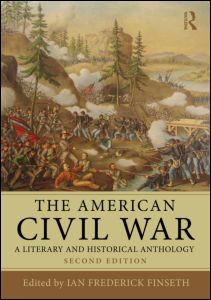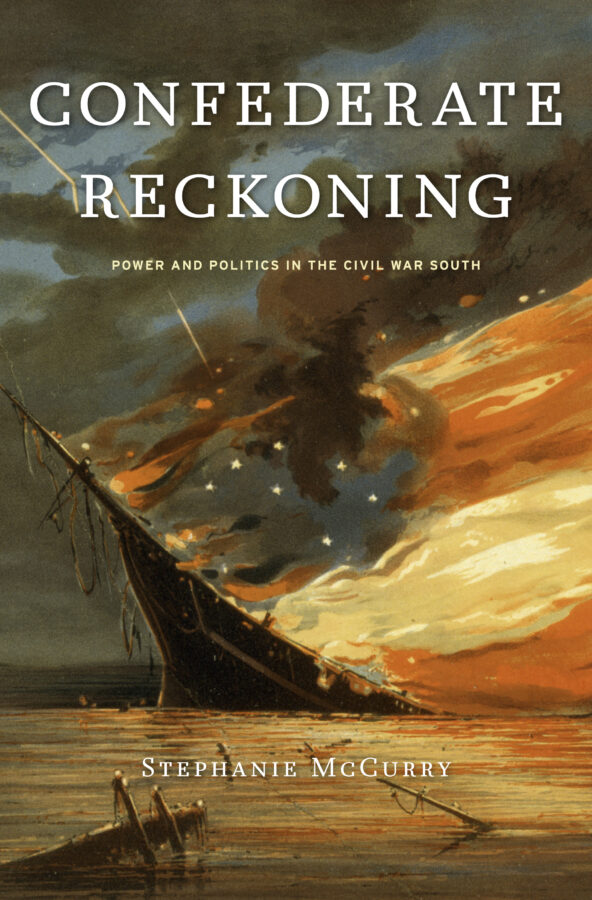The American Civil War: A Literary and Historical Anthology, Second Edition, edited by Ian Frederick Finseth. Routledge, 2013. Paper, ISBN: 041553707X. $54.95.
 Anthologies of the American Civil War frequently lose sight of the individual trees in their efforts to capture some coherent picture of the forest, and the result is too often a stilted statistical march through battles, leaders, and time. This second edition of Ian Finseth’s literary and historical anthology of that conflict surveys the forest as a complex ecosystem comprised of many individual and inter-related trees. It combines everything from “Abraham Lincoln’s private jottings and Frederick Douglass’s public speeches,” to “Herman Melville’s war poetry and Louisa May Alcott’s shorts stories, Mary Chesnut’s diary entries and Loreta Velazquez’s postwar memoir—among many other writings” to forge an in-depth look at the war through the eyes of those who “lived through the Civil War itself or its long aftermath, as participants or observers, or both, and always as commentators” (xiii-xiv). In doing so, Finseth seeks to “illustrate how the conflict was creatively interpreted, and continually reinterpreted, for a variety of audiences,” paying particular attention “to the conflicts of race and slavery that lay at the heart of the Civil War and that hardly abated in its echoing aftermath” (xiv). Believing that the “essential material of writing is language, and the essential material of war is violence,” Finseth—through his literary and historical selections—succeeds in showing how these materials “intertwine[d] in complex ways” during the Civil War, representing “part of the wider cultural effort to come to terms with the changes the United States underwent during the late nineteenth century” (3, 10).
Anthologies of the American Civil War frequently lose sight of the individual trees in their efforts to capture some coherent picture of the forest, and the result is too often a stilted statistical march through battles, leaders, and time. This second edition of Ian Finseth’s literary and historical anthology of that conflict surveys the forest as a complex ecosystem comprised of many individual and inter-related trees. It combines everything from “Abraham Lincoln’s private jottings and Frederick Douglass’s public speeches,” to “Herman Melville’s war poetry and Louisa May Alcott’s shorts stories, Mary Chesnut’s diary entries and Loreta Velazquez’s postwar memoir—among many other writings” to forge an in-depth look at the war through the eyes of those who “lived through the Civil War itself or its long aftermath, as participants or observers, or both, and always as commentators” (xiii-xiv). In doing so, Finseth seeks to “illustrate how the conflict was creatively interpreted, and continually reinterpreted, for a variety of audiences,” paying particular attention “to the conflicts of race and slavery that lay at the heart of the Civil War and that hardly abated in its echoing aftermath” (xiv). Believing that the “essential material of writing is language, and the essential material of war is violence,” Finseth—through his literary and historical selections—succeeds in showing how these materials “intertwine[d] in complex ways” during the Civil War, representing “part of the wider cultural effort to come to terms with the changes the United States underwent during the late nineteenth century” (3, 10).
Finseth organizes the documents into five thematic sections labeled “Origins,” “Battlefields,” “African American Experience,” “The Home Front,” and “Reconstructing.” Each section includes a poignant and concise overview of the documents and their relation to the theme. Many of the individual readings include short biographical or historical introductions and notes that guide the reader through the sections. Finseth argues that the documents in each section collectively reveal how “all writings on the war communicated, perforce, a particular vision of the nation’s past and future, whether implicitly or explicitly,” and in so doing exhibit their “titanic, slow-motion struggle with each other to determine how the nation would understand regional identity, civil rights, economic growth, and moral responsibility for the war and its aftermath” (6).
Civil War scholars will recognize many if not most of the writers and leaders, stories, poems, and speeches collected in this volume. Lincoln and Davis, Douglass and Stephens, Chesnut and Stowe, Bierce and Crane, Pollard and Twain—all appear conspicuously throughout. Other voices, however, expand upon this well-trodden narrative with a refreshing personal and emotional tack that incorporates male and female, black and white, patrician and plebian. Harriet Martineau’s “Election of Abraham Lincoln” (1860), Lucy Larcom’s “The Sinking of the Merrimack” (1863), Frances Ellen Watkins Harper’s “The Massachusett’s Fifty-Fourth” (1863), Sarah Morgan Bryan Piatt’s “Giving Back the Flower” (1867); and Rebecca Harding Davis’ “The Mean Face of War” (1899), offer just one glimpse into the expansive female perspective included here. Poems like Henry Timrod’s “Ethnogenesis” (1861), Walt Whitman’s “Vigil Strange I Kept on the Field One Night” (1865), and Paul Laurence Dunbar’s “The Deserted Plantation” (1895), as well as short stories like Hamlin Garland’s “The Return of a Private” (1891), or memoirs like Mattie J. Jackson’s “The Story of Mattie J. Jackson” (1866) further capture the diversity of genres and perspectives collected in this volume. Indeed, by focusing on the literary narration and memory of the war and its aftermath, Finseth has provided a more individual and emotional voice through which to capture the multifaceted experience of the war and its effects. Collectively these diverse individual accounts present a compelling portrait of Civil War causes, conflicts, and memories that undergraduate students will eagerly engage and established scholars can readily employ.
Enhancing the anthology’s suitability to the classroom is the companion website, which includes additional primary texts and images that supplement and complement the printed volume. The website also proffers “a variety of pedagogical resources…including discussion questions and essay topics” designed to augment the book’s classroom utility. Taken together, this anthology and its companion website offer teachers and students alike a chance to encounter Civil War actors in their own words. While Finseth admits that this individualized and literary perspective presents the war in all its “precarious, imperfect, and incomplete” dimensions, he asserts that it also enables students and scholars to accomplish “an essential part of coming to terms with [the Civil War’s] unresolved status in the American imagination” by exploring “how earlier generations came to terms with it” (10-11).
James Hill Welborn III is a Doctoral Candidate in History at the University of Georgia.
